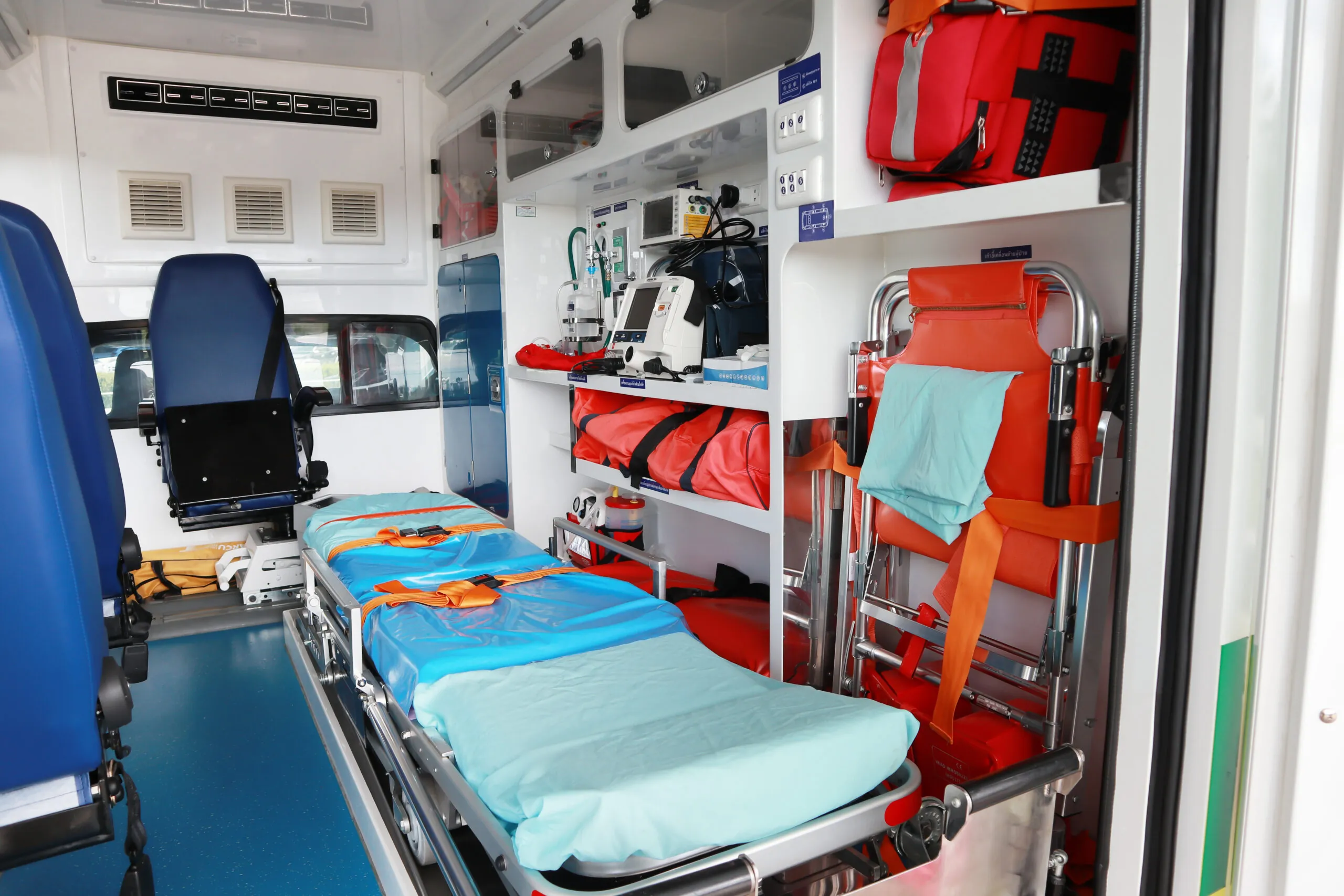Exploring the Inside of an Ambulance: Orienting New EMTs and Paramedics

So, you're bringing on a new team member. It's crucial to orient new EMTs and Paramedics to everything on the unit. It's helpful to go through all the different components and ensure they know how to find everything on the inside of an ambulance long before they respond to a call to help a patient. Like most things in life, preparation is essential.
Even if you're hiring experienced personnel, it's important to recognize that every group, organization, and every station operates a little differently. Here are some best practices to implement when onboarding new EMTs and Paramedics while showing them around the inside of their rig.
The Inside of an Ambulance
When emergency responders get the call, their unit (bus, rig, rescue, or ambulance-whatever term your team uses) essentially becomes an ER on wheels. With lifesaving equipment on board, first responders are ready to face any situation, whether it's a heart attack or cardiac arrest, a head injury, breathing problems, an allergic reaction, or a young patient needing medical help. The first thing they do at the beginning of a shift is a rig check to ensure they have all the necessary lifesaving medications and supplies.
Inside of an ambulance, there is a long list of equipment and supplies; a gurney, assessment tools such as blood pressure cuffs, a cervical collar and other c-spine supplies, IV kits and saline drips, an oxygen cylinder, defibrillators, and much more. Although EMTs and Paramedics aren't typically performing invasive medical testing or surgery, they must act quickly to stabilize patients enough for transport to the nearest emergency room or trauma center. They perform a thorough patient assessment, including taking a patient's blood pressure, heart rate, and all the other necessary vital signs to ensure they're offering the right medical treatment. In a multi-casualty incident (MCI), they also need to be proficient in their rapid assessments and perform quick triage to assess any situation's urgency and prioritize who needs medical help first. Emergency services personnel are trained in both advanced and basic life support but ultimately rely on their supplies and equipment to do their jobs as EMTs and Paramedics.
The ambulance equipment and inventory lists often include life-saving medications, including emergency meds like epinephrine, Glucagon, Naloxone, and other medicines that can assist when providing emergency services. Of course, some of these medications are controlled substances, so inside of an ambulance, you'll find a lockbox where these medications are stored.
In addition to the items on the ambulance equipment list, there are also all the essential components of any vehicle. EMTs may not need to know exactly what's under the hood of their unit, but they will need a cursory knowledge of vehicular safety and care.
EMTs and Paramedics go through extensive training-both in terms of clinical education and emergency vehicle training. They learn how to pull up knowledge under pressure and how to keep a cool head. They learn about general emergency response and how to perform all the needed lifesaving actions. They also should know how to work as a team with their fellow firefighters, EMTs, and Paramedics.
As You Onboard New EMTs and Paramedics
When you bring on new EMTs and Paramedics, it's essential to engage in a clear, structured process to ensure that they're comfortable with everything that goes on inside an ambulance. New EMTs and Paramedics should generally partner with someone experienced and ready to walk them through processes and procedures, often referred to as a Field Training Officer (FTO). While they will be familiar with basic life support and advanced life support as a Paramedic, each organization has its own policies and procedures to meet the local EMS protocols.
Leadership must encourage their team members not to rely on past experience from another organization. Each organization can operate a little differently, and even though someone comes in with extensive training in emergency medical services, it's important to learn the practices and adhere to the policies of the agency they're working with. It's easy to make mistakes under pressure, and in emergency response, there's no room for error.
So how can you orient new members to the inside of an ambulance and help them get their bearings?
1. Assign a Mentor or Preceptor
One of the best practices when orienting new EMTs and Paramedics is to assign them an experienced partner, preceptor, or mentor. This person can help them navigate the inside of an ambulance, station, culture, and more. Even fully-trained and certified paramedics and other emergency responders should shadow their mentors during shifts for at least a week or two. Don't just rely on an orientation manual and a virtual tour of the ambulance-assign them a partner who can ensure consistency during those critical first few weeks.
While it can be tough to spare the staff, especially if your personnel is already stretched thin, it's far better to onboard team members the right way and start them out on the right track. New members might also feel more comfortable fielding questions or concerns to a peer. Building rapport will help them feel included right away and have a sense of ownership in the organization.
2. Build a Leadership Connection
While peer-to-peer connections are crucial, especially in emergency response, it's also helpful to have a strong connection to management. This may mean having team leaders take time to welcome the new member to the team first thing with a personal note, lunch, or even a leisurely one-on-one conversation.
So often in emergency services, we rush on to the next situation. Having a supervisor or team leader take the time to build a connection with a new hire will go a very long way in the months and years to come. You only get one shot at a first impression.
3. Clearly Outline Protocols and Expectations
When and how should new hires perform rig checks? Where are ambulance equipment lists stored and accessed? How should staff log the administration of controlled substances? The administration should clearly outline these policies and procedures in your employee manual. More importantly, everyone on the team should follow them to the letter. These aren't areas that one can cut corners with.
If it's been a while since your team had a new member come on board, you might need to take the time to walk them through the policies and procedures. What happens when they go on a call, from getting out the door to dropping off the ill patient? Explain every regular occurrence inside an ambulance and out. Touch on the most common issues they will face when helping a patient and how they should approach every scenario. Welcoming a new hire is a great time to tighten any gaps, strengthen your policies, and stress accountability.
4. Focus on Team Wellness
There's a lot to take in during those first few weeks and months on the job. When the rubber (literally) hits the road, the stress of emergency services can take a toll on anyone-especially those working through it for the first time. Be sure you have team wellness check-ins in place and encourage your new team members to familiarize themselves with the warning signs of stress and burnout, including the symptoms of a panic attack, exhaustion, and other signs that they're under pressure. Stress and PTSD is inevitable on a long enough timeline for first responders.
In the world of emergency medical response, heroes often don't want to trouble others with their stress or might feel like they should always put on a brave face. It's vital to foster a culture of sharing and opening up, whether they're with their team in an ambulance or spending time at the station between calls. Make time to create a supportive environment. What's predictable is preventable!
Embracing Technology on the Job
Between lifesaving equipment, checking the rig and equipment, there's a lot of technology involved in emergency response. It's important that new members feel comfortable with everything they need to handle long before they really need to perform under pressure.
Make sure the equipment is as user-friendly as possible. Ensure that everyone on your team is extremely familiar with every item on the rig-even those that they rarely have to use. Often the rarely used equipment is some of the most critical. Everyone on your team should know their way around the inside of an ambulance, including all the equipment and lifesaving medications.
You can make the job of emergency services easier on your team with LogRx. LogRx is a controlled substance tracking app that works right from the phones and devices of your team. With a simple scan from their tablet or smartphone's camera, they can log and report every substance they use or dispose of. There are no paper logs to keep track of or complicated software or extra equipment required.
LogRx helps you protect your team and your organization from the serious consequences of failing an audit or mistracking controlled substances. Mistakes in your report can result in fines, legal ramifications, and serious damage to your reputation. With LogRx, we take the worry about controlled substance tracking and make it easy for your entire team. Our user-friendly solution helps you easily track, check inventory levels, and report. It's almost like having another member on staff.
For administration, you'll rest easy knowing that proper narcotics tracking helps you avoid the hazards of diversion and stress during reporting time. With a glance at your dashboard in the admin portal, you'll know exactly where everything is, including dispensing records, quantities, and locations.
LogRx is perfect for teams on the go-it works efficiently from handheld devices like tablets or phones. Scan the tag using your phone's camera, and track it in real time. Should your team venture outside of cell coverage, WiFi, or simply put in airplane mode, you can continue using LogRx. Once your phone regains cell or WiFi service, LogRx uploads the data with time stamps and GPS tracking from the time activity occurred while off-line.
Help your team stay compliant, organized, and effective with LogRx. We make it simple to keep track of your controlled substances. A lot is going on inside an ambulance, and tracking controlled substances with LogRx ensures you'll have one less thing to worry about! To learn more about how LogRx can support your team, reach out today!
Categories
Recent Posts
- LogRx and Knox: How LogRx Integrates with EMS Medication Lockboxes
- Connecting Community and EMS: 7 EMS Community Outreach Ideas
- Projecting Professionalism: Why EMS Uniforms Matter
- EMT Off-Duty Response: What You Should Carry Everywhere
- Basic EMT Trauma Assessment Scenarios: Gearing Up for Certification


















.webp?t=1766386393821)































